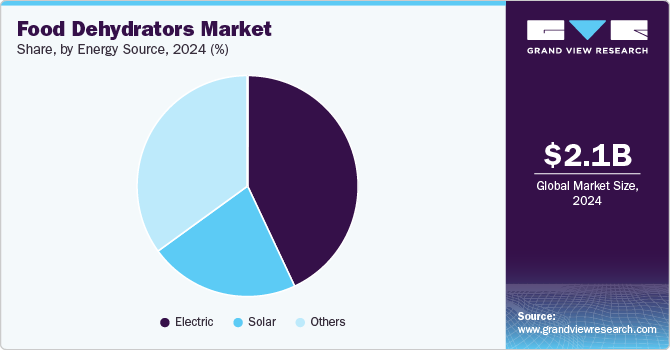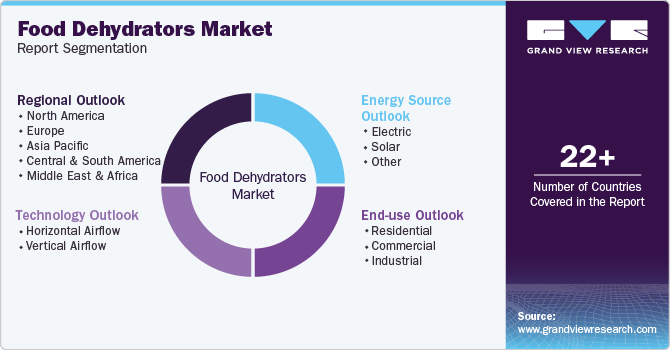- Home
- »
- Advanced Interior Materials
- »
-
Food Dehydrators Market Size, Share & Growth Report, 2030GVR Report cover
![Food Dehydrators Market Size, Share & Trends Report]()
Food Dehydrators Market Size, Share & Trends Analysis Report By Technology (Horizontal Airflow, Vertical Airflow), By End-use (Residential, Industrial), By Energy Source, By Region, And Segment Forecasts, 2025 - 2030
- Report ID: GVR-3-68038-903-6
- Number of Report Pages: 152
- Format: PDF, Horizon Databook
- Historical Range: 2018 - 2023
- Forecast Period: 2025 - 2030
- Industry: Advanced Materials
Food Dehydrators Market Size & Trends
The global food dehydrators market size was estimated at USD 2,080.2 million in 2024 and is projected to grow at a CAGR of 5.4% from 2025 to 2030. The market has witnessed significant growth in recent years, driven by increasing consumer awareness of healthy eating and the desire for convenient food preservation methods. As more people seek to reduce food waste and extend the shelf life of fruits, vegetables, and meats, dehydrators have become a popular kitchen appliance. Innovations in technology, such as energy-efficient models and user-friendly features, have also contributed to the market's expansion, appealing to both novice cooks and seasoned chefs.

In addition, the rise of outdoor and health-focused lifestyles has further fueled the demand for food dehydrators. With more individuals engaging in activities such as camping, hiking, and home gardening, the ability to prepare nutritious snacks and meals on the go has gained traction. The trend towards DIY food preservation, coupled with the growing popularity of plant-based diets, has also bolstered sales. As consumers increasingly prioritize sustainability and self-sufficiency, the market is expected to continue its upward trajectory in the coming years.
Drivers, Opportunities & Restraints
A key driver of the market is the rising consumer demand for healthy, preservative-free snacks. As more people become health-conscious and prioritize nutritious eating, the appeal of dehydrated foods-such as fruits, vegetables, and jerky-has grown. Furthermore, the trend toward reducing food waste has led many consumers to invest in food dehydrators, allowing them to preserve surplus produce and create homemade snacks without additives.
One notable restraint in the market is the initial cost of purchasing these appliances, which can deter budget-conscious consumers. While prices have become more competitive, higher-end models with advanced features may still be considered an investment. In addition, the time and effort required for preparation and dehydration can discourage some potential users who prefer quicker, more convenient cooking methods.
The growing interest in home cooking and DIY food preservation presents significant opportunities for market growth. As more consumers look to experiment with flavors and textures, manufacturers can capitalize on this trend by offering innovative products, such as multifunctional dehydrators that incorporate additional cooking capabilities. Furthermore, expanding marketing efforts to highlight the versatility and health benefits of dehydrated foods can attract a broader audience, particularly among younger generations seeking convenient and healthy meal options.
Technology Insights
“The demand for the vertical airflow technology segment is expected to grow at a significant CAGR of 6.7% from 2025 to 2030 in terms of revenue.”
The horizontal airflow technology segment led the market and accounted for 73.7% of the global revenue share in 2024. Horizontal airflow food dehydrators are increasingly favored by consumers due to their efficient and uniform drying capabilities. This design allows for consistent airflow across all trays, minimizing the risk of uneven drying and maximizing output. As home cooks and health enthusiasts seek to produce high-quality dehydrated foods, horizontal airflow models have become popular for their ability to preserve flavor, texture, and nutrients effectively. The growing trend of bulk dehydration for meal prep and food storage has further fueled demand for these models, as they can handle larger quantities simultaneously without compromising quality.
Vertical airflow food dehydrators continue to attract consumers, especially those looking for compact and budget-friendly options. These models often feature a stackable design, making them ideal for small kitchens or for individuals who need a dehydrator for occasional use. The vertical airflow design is typically more straightforward and easier to operate, appealing to novice users who appreciate the simplicity. As awareness of healthy snacking and food preservation grows, the accessibility and lower price point of vertical airflow dehydrators make them a popular choice for first-time buyers and casual users.
End-use Insights
“The demand for the residential end use segment is expected to grow at a significant CAGR of 6.5% from 2025 to 2030 in terms of revenue.”
The industrial end use segment led the market and accounted for 43.3% of the global revenue share in 2024. In the industrial sector, food dehydrators are employed for large-scale food processing and preservation, playing a crucial role in the production of dried fruits, vegetables, herbs, and other ingredients for commercial use. These high-capacity dehydrators are designed for efficiency and consistency, ensuring that large quantities of product can be dried uniformly while maintaining quality and flavor. Industries such as snacks, ready-to-eat meals, and health food production benefit from the scalability of industrial dehydrators, as they help meet the rising consumer demand for convenient and nutritious food options.
In the residential sector, food dehydrators are primarily used for personal food preservation and healthy snacking. Home cooks and health-conscious individuals utilize these appliances to create dried fruits, vegetables, and jerky, catering to a growing preference for natural, preservative-free options. Dehydrators also support DIY meal prep, allowing families to stock up on nutritious snacks and ingredients for later use. The versatility and ease of use make them an appealing choice for households looking to minimize food waste and maximize the shelf life of seasonal produce.
Energy Source Insights
“The demand for the solar energy source segment is expected to grow at a significant CAGR of 6.7% from 2025 to 2030 in terms of revenue.”
The electric energy source segment led the market and accounted for 43.0% of the global revenue share in 2024. The demand for electric food dehydrators remains strong due to their convenience, efficiency, and consistent performance. Electric models are popular among home cooks and professionals alike for their ability to provide precise temperature controls and reliable drying times, which are essential for achieving optimal results. As consumers prioritize convenience and ease of use, electric dehydrators are favored for their straightforward operation and quick setup. In addition, advancements in technology have led to more energy-efficient models, further enhancing their appeal in a market increasingly focused on sustainability.

The demand for solar energy food dehydrators is on the rise, particularly among eco-conscious consumers and those in regions with abundant sunlight. These models appeal to individuals seeking sustainable and energy-saving alternatives to traditional electric dehydrators. Solar dehydrators harness renewable energy to dry fruits, vegetables, and herbs, aligning with the growing trend of off-grid living and self-sufficiency. As awareness of environmental issues increases, more people are turning to solar dehydrators not only for their low operational costs but also for their ability to reduce carbon footprints, making them an attractive option for environmentally minded consumers.
Regional Insights
North America food dehydrators market accounted for 37.2% of the global revenue share in 2024. The demand for food dehydrators in North America is robust, driven by a growing trend towards home food preservation and healthy eating. Consumers are increasingly interested in creating their snacks, such as dried fruits and jerky, which has led to a surge in sales of both electric and solar models. For instance, brands such as Excalibur and Nesco have gained popularity among American households looking for reliable dehydrators that offer large capacity and efficiency.

U.S. Food Dehydrators Market Trends
The food dehydrators market in the U.S. is expected to grow at a CAGR of 5.3% from 2025 to 2030. In the U.S., the food dehydrator market is significantly influenced by the rise of health and wellness trends. Consumers are keen on minimizing food waste and making healthy snacks. The popularity of home gardening and seasonal produce preservation has further fueled demand.
The Canada food dehydrators market is expected to grow at a CAGR of 6.9% from 2025 to 2030. Canadian consumers are increasingly adopting food dehydrators as part of their effort to maintain a healthy lifestyle, particularly in regions with harsh winters when fresh produce is less accessible. Brands like Cabela's and Harvest Right cater to this market by providing dehydrators designed for freezing and drying a variety of foods.
The food dehydrators market in Mexico is expected to grow at a CAGR of 7.1% from 2025 to 2030. In Mexico, the demand for food dehydrators is rising as traditional methods of food preservation are combined with modern technology.
Europe Food Dehydrators Market Trends
The food dehydrators market in Europe held a significant global market share in 2024. The European market for food dehydrators is expanding, particularly in countries with a strong culture of food preservation, such as Italy and France. Consumers are drawn to dehydrators for making traditional snacks and preserving seasonal fruits and vegetables. European brands like Aicok are focusing on sleek designs and multifunctional features, catering to a growing audience that values both aesthetics and functionality in their kitchen appliances.
Germany food dehydrators market held a 27.7% revenue share of the European market In Germany, there is a notable trend toward health-conscious eating and self-sufficiency, which has spurred interest in food dehydrators. Consumers are using these appliances not only for traditional drying but also for preparing organic snacks and meals. Brands such as Klarstein offer high-quality models that appeal to eco-minded consumers, reflecting Germany's emphasis on sustainability and healthy living.
The food dehydrators market in the UK has seen a surge in the popularity of food dehydrators as part of the broader trend of home cooking and food preservation. The interest in plant-based diets and natural snacks has led consumers to explore dehydrated options. Brands like Andrew James provide versatile dehydrators that cater to this market, allowing users to create everything from dried fruits to vegetable chips easily, aligning with the UK's focus on health and sustainability.
Asia Pacific Food Dehydrators Market Trends
“India to witness fastest market growth at 7.3% CAGR”
The Asia Pacific food dehydrators market is witnessing increasing demand for food dehydrators, particularly in countries like Japan and Australia. Consumers are increasingly adopting dehydrated foods for their convenience and health benefits. Japanese brands like Zojirushi are offering compact, efficient models that appeal to urban dwellers, while Australian consumers are exploring both traditional and innovative uses for dehydrators, such as making snacks from native ingredients.
China food dehydrators market held a 42.0% revenue share of the Asia Pacific region. China's market is witnessing rapid growth, driven by rising urbanization and changing consumer lifestyles. As more people seek convenience and health in their diets, dehydrators are becoming popular for making snacks like dried fruits and vegetables.
The food dehydrators market in India is expected to grow at a CAGR of 7.3% from 2025 to 2030. In India, the market is emerging as consumers become more health-conscious and seek convenient ways to preserve food. The increasing popularity of snacks like dehydrated fruits and vegetables is driving demand for these appliances.
Middle East & Africa Food Dehydrators Market Trends
The Middle East and Africa food dehydrators market is emerging as consumers look for effective ways to preserve food in regions where fresh produce availability can be inconsistent. The demand for dehydrators is particularly evident in countries like South Africa and the UAE, where health-conscious consumers are interested in making their snacks. Brands are beginning to introduce models tailored to local tastes, focusing on the preservation of fruits and herbs commonly used in regional cuisines.
The UAE food dehydrators market is witnessing growing demand as health-conscious consumers increasingly seek convenient ways to preserve fresh produce and create nutritious snacks. The rise of the wellness movement, coupled with a diverse expatriate population interested in various culinary traditions, has spurred interest in dehydrated foods such as dried fruits and vegetable chips. Brands like Cuisinart and Aicok are gaining traction in the market, offering high-quality dehydrators that cater to the region's focus on health and gourmet cooking.
Latin America Food Dehydrators Market Trends
The Latin America food dehydrators market is witnessing gradually increasing demand, particularly in countries like Brazil and Argentina, where traditional preservation methods are common. Consumers are beginning to embrace modern dehydrators for making healthy snacks and preserving seasonal produce. Local manufacturers are exploring this trend by developing affordable, user-friendly models that resonate with health-conscious consumers eager to minimize food waste.
The food dehydrators market in Brazil is driven by increasing demand for food dehydrators as consumers become more aware of healthy eating habits and the benefits of food preservation. The country’s rich agricultural sector provides an abundance of fruits and vegetables, leading to increased interest in dehydrating techniques to minimize waste and create delicious snacks like banana chips and dehydrated guava. Local brands such as Mallory are catering to this market by offering affordable and efficient dehydrators that appeal to home cooks.
Key Food Dehydrator Company Insights
Some of the key players operating in the market for food dehydrators include JBT Corporation and Koolatron Corporation among others.
-
JBT Corporation is a global leader in food processing and packaging solutions, specializing in technologies that enhance food quality, safety, and efficiency. Founded in 1884 and headquartered in Chicago, Illinois, JBT serves various sectors, including meat, poultry, seafood, and dairy industries. The company offers a diverse range of products and services, including automated systems, food processing equipment, and post-harvest solutions.
-
Koolatron Corporation, established in 1983 and based in Brantford, Ontario, Canada, is a prominent manufacturer and distributor of consumer appliances, particularly known for its innovative cooling and food preservation products. The company specializes in producing electric food dehydrators, wine coolers, and portable refrigerators, catering to the needs of health-conscious consumers and outdoor enthusiasts. Koolatron emphasizes quality and functionality, combining modern technology with user-friendly designs.
Vitality4Life Pty Limited and Guangdong IKE Industries Co., Ltd. are some of the emerging players in the food dehydrators market.
-
Vitality4Life Pty Limited is an Australian company dedicated to promoting health and wellness through innovative kitchen appliances and wellness products. Founded in 1999, the company specializes in high-quality food dehydrators, juicers, and other health-related appliances designed to help consumers adopt healthier lifestyles. With a strong commitment to sustainability and eco-friendly practices, Vitality4Life focuses on creating products that enhance nutritional intake while minimizing environmental impact. Their offerings are well-regarded for combining advanced technology with user-friendly designs, making healthy living accessible to a wide audience.
-
Guangdong IKE Industries Co., Ltd. is a Chinese manufacturer known for producing a diverse range of kitchen appliances, including food dehydrators, vacuum sealers, and electric cookware. Established in 2003 and headquartered in Guangdong, the company focuses on innovation and quality, ensuring its products meet international standards. IKE Industries places a strong emphasis on research and development, enabling them to create efficient and user-friendly appliances that cater to the growing demand for healthy cooking and food preservation. With a robust export strategy, IKE has successfully penetrated various global markets, building a reputation for reliability and customer satisfaction.
Key Food Dehydrator Companies:
The following are the leading companies in the food dehydrator market. These companies collectively hold the largest market share and dictate industry trends.
- Tribest Corporation
- Koolatron Corporation
- Excalibur Dehydrator
- National Presto Industries, Inc.
- Lem End Uses Holding LLC
- Hamilton Beach Brands, Inc.
- The Sausage Maker, Inc.
- Aroma Housewares Company
- JBT Corporation
- STX International
- Avantco Equipment
- National Enameling and Stamping Company (NESCO)
- Vitality4Life Pty Limited
- Kihara Works Co., Ltd.
- Guangdong IKE Industrial Co., Ltd.
Recent Developments
- In December 2022, the Food Drying Co. announced the launch of its new drying hub network in New Zealand. This facility will provide services to both animal and human food processors, featuring premium-grade capabilities based on leasing agreements. The company intends to secure a new round of funding to support this initiative.
Food Dehydrators Market Report Scope
Report Attribute
Details
Market size value in 2025
USD 2,177.6 million
Revenue forecast in 2030
USD 2,838.4 million
Growth rate
CAGR of 5.4% from 2025 to 2030
Historical data
2018 - 2023
Forecast period
2024 - 2030
Quantitative units
Revenue in USD million/billion, and CAGR from 2025 to 2030
Report coverage
Revenue forecast, company ranking, competitive landscape, growth factors, and trends
Segments covered
Technology, end-use, energy source, region
Country scope
U.S.; Canada; Mexico; UK; Germany; France; Italy; China; India; Japan; Australia; Brazil; Argentina; UAE; South Africa
Key companies profiled
Tribest Corporation, Koolatron Corporation, Excalibur Dehydrator, National Presto Industries, Inc., Lem End Uses Holding LLC, Hamilton Beach Brands, Inc., The Sausage Maker, Inc., Aroma Housewares Company, JBT Corporation, STX International, Avantco Equipment, National Enameling and Stamping Company (NESCO), Vitality4Life Pty Limited, Kihara Works Co., Ltd., Guangdong IKE Industrial co., Ltd.
Customization scope
Free report customization (equivalent to up to 8 analysts' working days) with purchase. Addition or alteration to country, regional & segment scope.
Pricing and purchase options
Avail customized purchase options to meet your exact research needs. Explore purchase options
Global Food Dehydrators Market Report Segmentation
This report forecasts revenue growth at global, regional & country levels and provides an analysis on the industry trends in each of the sub-segments from 2018 to 2030. For this study, Grand View Research has segmented the global food dehydrators market report based on technology, end-use, energy source, and region:

-
Technology Outlook (Revenue, USD Million, 2018 - 2030)
-
Horizontal Airflow
-
Vertical Airflow
-
-
End-use Outlook (Revenue, USD Million, 2018 - 2030)
-
Residential
-
Commercial
-
Industrial
-
-
Energy Source Outlook (Revenue, USD Million, 2018 - 2030)
-
Electric
-
Solar
-
Other
-
-
Regional Outlook (Revenue, USD Million, 2018 - 2030)
-
North America
-
U.S.
-
Canada
-
Mexico
-
-
Europe
-
UK
-
Germany
-
France
-
Italy
-
-
Asia Pacific
-
China
-
India
-
Japan
-
Australia
-
-
Central & South America
-
Brazil
-
Argentina
-
-
Middle East & Africa
-
UAE
-
South Africa
-
-
Frequently Asked Questions About This Report
b. The global food dehydrators market size was estimated at USD 2,080.2 million in 2024 and is expected to reach USD 2,177.6 million in 2025.
b. The global food dehydrators market, in terms of revenue, is expected to grow at a compound annual growth rate of 5.4% from 2025 to 2030 to reach USD 2,838.4 million by 2030.
b. The electric energy source segment led the market and accounted for 43.0% of the global revenue share in 2024. The demand for electric food dehydrators remains strong due to their convenience, efficiency, and consistent performance.
b. Some of the key players operating in the food dehydrators market include Tribest Corporation; Koolatron Corporation; Excalibur Dehydrator; National Presto Industries, Inc.; Lem Products Holding LLC; Hamilton Beach Brands, Inc.; The Sausage Maker, Inc.; Aroma Housewares Company; JBT Corporation; STX International; Avantco Equipment; National Enameling and Stamping Company (NESCO); Vitality4Life Pty Limited; Kihara Works Co., Ltd.; Guangdong IKE Industrial co., Ltd.
b. Key factors driving the food dehydrator market is rising product awareness, technological development, industrial expansion, and rising concerns over food waste
Share this report with your colleague or friend.
![gvr icn]()
NEED A CUSTOM REPORT?
We can customize every report - free of charge - including purchasing stand-alone sections or country-level reports, as well as offer affordable discounts for start-ups & universities. Contact us now
![Certified Icon]()
We are GDPR and CCPA compliant! Your transaction & personal information is safe and secure. For more details, please read our privacy policy.
We are committed towards customer satisfaction, and quality service.
"The quality of research they have done for us has been excellent."





